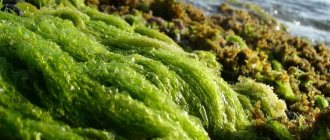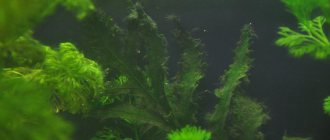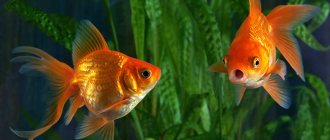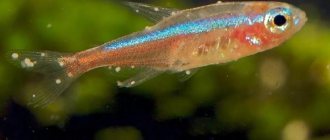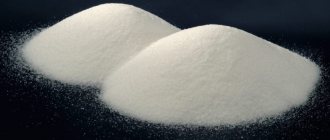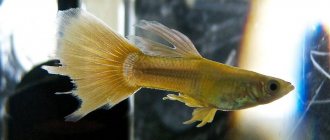Aquarist's Guide
The use of medicinal solutions in a general aquarium has two goals: freeing the fish’s body from infectious elements by exposing it to a medicinal drug and preserving the aquatic vegetation present in the aquarium during the period of treatment of the fish. The concentration of the treatment solution should not be toxic to fish and plants. During the entire course of treatment of sick fish, soil and aquatic vegetation are left in a common aquarium. The duration of treatment depends on the biological characteristics of the pathogen, its location, the degree of damage to the fish and its condition. Typically, treatment is carried out until the fish are completely cured and lasts from six days to a month, and sometimes longer.
Method of preparing a medicinal solution. In a bottle (glass, flask) with a capacity of 200-250 ml, carefully dissolve a certain amount of the drug, strictly calculated for the entire volume of water in the aquarium. Then the concentrated solution from the bottle is gradually poured into the aquarium in equal portions in three doses at intervals of 20-30 minutes, while carefully stirring the water. For faster and more uniform mixing of the solution after adding it to the aquarium, you can temporarily (for 20-30 minutes) turn on the aeration unit. It is unacceptable to pour the entire treatment solution into the aquarium water at once.
In all cases, use only freshly prepared solutions.
Healing solution of table salt
(NaCl) for the entire volume of water in the aquarium where sick fish will be treated is prepared at the rate of one full tablespoon of table salt per 10 liters of water. The temperature of the aquarium water can be raised to 30-32° within 2-3 days while simultaneously aerating it. Treatment lasts on average 10-30 days. At the end of treatment, the water in the aquarium is replaced with fresh water in 2-3 doses.
Healing solution of artificial sea water
in a general aquarium where sick fish are kept and where they will be treated, the amount is 100-150 ml (0.5-0.75 cups) of sea water per 10 liters of aquarium water.
To prepare artificial sea water, per 10 liters of water take 277 g of sodium chloride, 69 g of magnesium sulfate, 55 g of magnesium chloride, 7 g of potassium chloride, 3 g of sodium bicarbonate, 1 g of sodium nitrate, 1 g of sodium bromide, 0.5 g of disubstituted sodium phosphate, 0.05 g of potassium iodide, 0.15 g of strontium chloride and separately in a small amount of water, dissolve 15 g of crystalline calcium chloride and add it to the general solution.
Solutions of table and sea salt are used to treat costiosis and trichodinosis.
To treat young and weakened fish, less concentrated solutions are used.
Trypaflavin medicinal solution.
Trypaflavin is a synthetic dye of orange-red or brownish-red color, highly soluble in water. It is used in doses of 0.6-1 g per 100 liters of water. The dose of trypaflavin calculated for the given volume of the aquarium is dissolved in 200 ml of water and gradually, stirring evenly, poured into the aquarium with sick fish. In this case, the water acquires a yellow-green tint, which almost completely disappears by the end of treatment (approximately on the 14th day). At the same time, the water temperature in the aquarium is increased to 30-32° and maintained at this level until the end of the course of treatment. As the temperature rises, it is necessary to establish intensive aeration of the water. The filters are turned off, since they will contribute to the evaporation of the medicinal drug from the water. If fish show signs of asphyxia, water aeration is increased and the water temperature is reduced to 28-300.
The described method of treating sick fish with trypaflavin in a general aquarium gives positive results only for costiosis and trichodinosis. Partially frees fish from Oodiniums, Ichthyophthirius, Chilodonella, Gyrodactylus and Dactylohyrus. Trypaflavin medicinal solution has a preventive effect against certain viral and bacterial infections. Tripaflavin is not suitable for combating fungal diseases of fish due to its insignificant effectiveness.
Medicinal solution of methylene blue.
Methylene blue is also a synthetic blue dye. The drug is used in the form of a 1% solution, which is dissolved in a common aquarium with sick fish at the rate of 3 ml per 10 liters of fresh aquarium water. The water turns blue, making it difficult to observe the fish. To free water from bright blue coloring at the end of the course of treatment, filters with activated carbon are used. Duration of treatment is up to one month.
Therapeutic solutions of methylene blue are used to combat costosis and trichodinosis. The drug partially acts on other ectoparasites.
Medicinal solution of copper sulfate.
Copper sulfate, or copper sulfate, is a strong poison for all aquatic organisms and aquarium vegetation. In this regard, when using it, the exact dosage should be observed. It is not recommended to use technical copper sulfate sold in hardware stores.
To prepare a stock solution, 1 g of chemically pure or analytically pure copper sulfate is dissolved in 1 liter of water. In this way a 0.1% solution of copper sulfate is obtained. Then 15 ml of it is diluted in 10 liters of aquarium water. The temperature of the water in the aquarium is not increased. Treatment lasts no more than 10 days. By gradually changing the water piece by piece, the medicinal solution in the aquarium is replaced with fresh water. The medicinal solution of copper sulfate gives positive results in the fight against fin rot, fungal and all ectoparasitic fish diseases.
Bicillin-5 medicinal solution
(Temporary instructions for the use of bicillin-5 for the therapeutic and prophylactic treatment of aquarium fish and vegetation, approved by the Head Vetupr of the USSR Ministry of Agriculture on June 30, 1974) Bicillin-5 (NN-dibenzyl-ethylenediamine salt of benzylpenicillin) is a white, odorless and tasteless powder, poorly soluble in water (0.32 mg/ml at 28°C). The drug is low-toxic, does not have cumulative properties, forms a homogeneous suspension with water, showing the most active effect in the first 2 hours after dilution. In bright light in water it decomposes quickly.
Every day for six days, a solution of bicillin-5 is added to the aquarium with sick fish at the rate of 500,000 BD (1/3 of the contents of the bottle) per 100 liters of water. Water hardness and pH do not matter. In a bottle with a capacity of 200-250 ml, the amount of bicillin-5 required for the given volume of the aquarium is quickly but carefully diluted and immediately added to the aquarium with sick fish. The temperature of the water in the bottle when diluting the antibiotic should be 28°.
A day before the start of treatment, the water temperature in the aquarium is adjusted to within 24-26°, which is maintained at the same level until the end of treatment. This water temperature promotes the rapid growth and reproduction process of the most dangerous fish parasites, which causes them to emerge from the epithelial tubercles of the skin and resting stages (cysts) into water containing doses of bicillin-5 that are toxic to them. Thus, the optimal temperatures for the development of Ichthyphthirius are 24-26°, for Oodinium pillularis 23-25°, for Costia 25-28°, for Dactylogyrus vastator 25°.
In addition, a water temperature of 24-26° is most favorable for keeping most aquarium fish. For cold-loving fish (genus Carassius and others), it is necessary to aerate the water. For other types of fish, water aeration is carried out depending on the density of the fish and the amount of aquatic vegetation in the aquarium.
It is better to add a medicinal antibiotic solution to the aquarium at night. When adding it during the day, the aquarium is shaded for 2 hours. Only freshly prepared solution is used daily.
Treatment of all aquarium fish without exception with bicillin-5 can begin from the age of 2 months, without fear of cases of poisoning. During treatment, fish are fed only with live crustaceans, bloodworms, tubifex and coretra. Give food no earlier than 2 hours after adding a medicinal antibiotic solution to the aquarium.
The described treatment method completely frees fish from the pathogens of oodiniumosis, ichthyophthyriosis, trichodinosis, bone disease, chylodonellosis, dactylogyrosis, gyrodactylosis, and fin rot. Promotes the healing of ulcers due to mycobacteriosis, ichthyosporgiosis and peptic ulcer disease, but does not cure fish from the three blight diseases.
Combined medicinal solution of malachite green and copper sulfate.
10 mg (technical) crystalline malachite green (oxalate) and 15 ml of 0.1% copper sulfate solution (CuSO4 • 5H2O) are diluted in 100 liters of aquarium water. The water temperature is increased to 28° and maintained at a given level until the end of the course of treatment at a pH of 5.5-6.8. Initial doses of medications are added to the aquarium water every 7-10 days. The course of treatment lasts up to a month or more.
This combined medicinal solution is used for fish diseases caused by many ectoparasites.
Biomycin medicinal solution.
Biomycin is an antibiotic. It is a crystalline powder of golden yellow color, low toxicity, and relatively soluble in water. Its synonym is chlortetracycline hydrochloride. Doses: 1.3-1.5 g per 100 liters of water. The temperature of the water in the aquarium is not increased, and the filters are not turned off. The duration of treatment is from 10 days to one month. Every 7 days, an initial dose of biomycin is added to the aquarium water. At the end of the course of treatment, the water in the aquarium is not changed.
The drug has a therapeutic effect in diseases of infectious origin, as well as in the treatment of mechanical damage to the outer integument of fish.
Treatment solution of white streptocide.
White streptocide is a white powder with a yellow tint. Gives a neutral reaction in water. This is a low-toxic sulfonamide drug. To prepare a medicinal solution, take streptocide at the rate of 10-20 g per 100 liters of water. Used for the same purpose and in the same order as the biomycin solution.
Rivanol medicinal solution. Rivanol
-yellow fine-crystalline powder, bitter taste, odorless. Relatively soluble in water. With increasing water temperature, its solubility increases. Dose - 0.2 g per 100 liters of water. The temperature of the water in the aquarium is not increased, and the filters are not turned off. The course of treatment is 14-16 days, after which the water in the aquarium is replaced with fresh water by adding the latter three times.
The medicinal solution of rivanol is used to combat ectoparasitic fish diseases.
To previous page
(Visited 2,625 times, 1 visits today)
The aquarium is turning green. What to do?
Green water in the aquarium becomes a constant headache for many aquarists. This problem is especially common for beginners in this business or people who have stopped monitoring the condition of the aquarium and rarely change the water. In addition, there are a large number of factors that cause the aquarium to turn green . The Land of Soviets will tell you how to prevent water discoloration.
The water in the aquarium turns green due to the rapid growth of algae . The word algae does not mean various plants of a higher order that you plant in the ground or leave to grow on the surface of the water. Algae are lower plants that we cannot see with the naked eye. They are the ones to blame for your aquarium turning green.
How to prevent algae growth and get rid of green water ? After all, it is impossible to completely sanitize all the inhabitants of the aquarium and equipment. And sometimes such measures are not at all necessary. After all, the aquarium will turn green due to a number of other reasons. First we should talk about lighting. Choose the right spectrum of aquarium lighting. To do this, you should not place the aquarium where it will be exposed to direct sunlight. The minimum distance from the rays should be 1.5 m. Most often, artificial lamps are used to illuminate the aquarium. Such light in the aquarium does not prevent plants from developing properly, and the fish feel great. Watch the light intensity. When the light is too bright, the fish become lethargic and algae begin to develop too quickly.
The aquarium also turns green for another reason, directly related to lighting - incorrect light conditions . In winter, the lighting of the aquarium should last no more than 8-10 hours a day. In summer, this time can be increased to 12 hours a day.
Sometimes, even with the right lighting, the water still turns green. The active reproduction of algae can be affected by contamination of water with food . The fish do not always eat all the food; it begins to accumulate at the bottom and pollute the water. In dirty water, chemical and biological processes are disrupted, which leads to the aquarium turning green. Therefore, try not to give your fish too much food. Ideally, the fish should eat all the food in 10-15 minutes.
The soil may contain various food debris and fish waste . Of course, good water filtration will help you deal with this problem to a certain extent. But in any case, good and timely cleaning of the soil will be required.
In a green aquarium you can add fish, snails or shrimp, which happily feed on algae remaining on the walls and stones of the aquarium. Some fish, especially if kept hand to mouth, are willing to spend days picking unsightly algae from the rocks and walls of the aquarium. Therefore, we advise you to get platies, mollies or catfish. But a couple of fish will not be able to completely cope with this problem. Therefore, you will also have to apply other measures to eliminate algae in the aquarium.
Even if you fully adhere to proper fish care measures, if your aquarium is still turning green, then it’s time to think about more effective methods of combating algae . You can use certain chemicals that are aimed at combating the growth of algae in the aquarium. Such drugs are sold in pet stores.
You can also make do with improvised means to prevent water from blooming. After all, the aquarium turns green due to an excessive amount of algae, which should be gotten rid of. Therefore, we suggest you use this remedy: dilute streptomycin powder in a small amount of boiled water. Take 3 mg of powder per liter of water in the aquarium. Introduce diluted streptomycin into the aquarium through the filter. This powder is absolutely harmless for fish and plants, but it will destroy algae in a few days.
Getting rid of the problem of water bloom is quite simple. But to prevent its contamination and flowering in the future, follow the rules for maintaining and caring for the aquarium.
Related publications:
Blue-green algae and its control
Yu.V.
- Irochka, do you want to laugh?
Tekhi
- Want. Why is there anything?
Yu.V.
- Eat.

